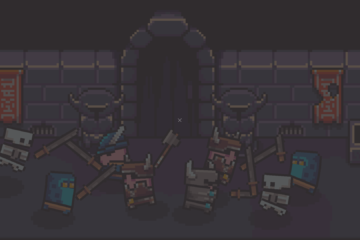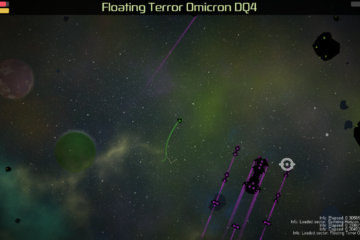I started working on Masteroid on April 24th, 2017 while at a small conference hosted by the creator of the FlatRedBall game engine. I got sick on the way to the conference and was miserable the first day. I drank a probably-dangerous amount of Monster energy drink and charged out of the achey fever with a strong urge to build something. While poking around in a “Game Stuff” dropbox folder I ran across a mockup I did for an abandoned game project years ago. Something about the mockup called to me and I decided to see if I could get a crude little space game roughed out by the end of the day. Here’s the old mockup:
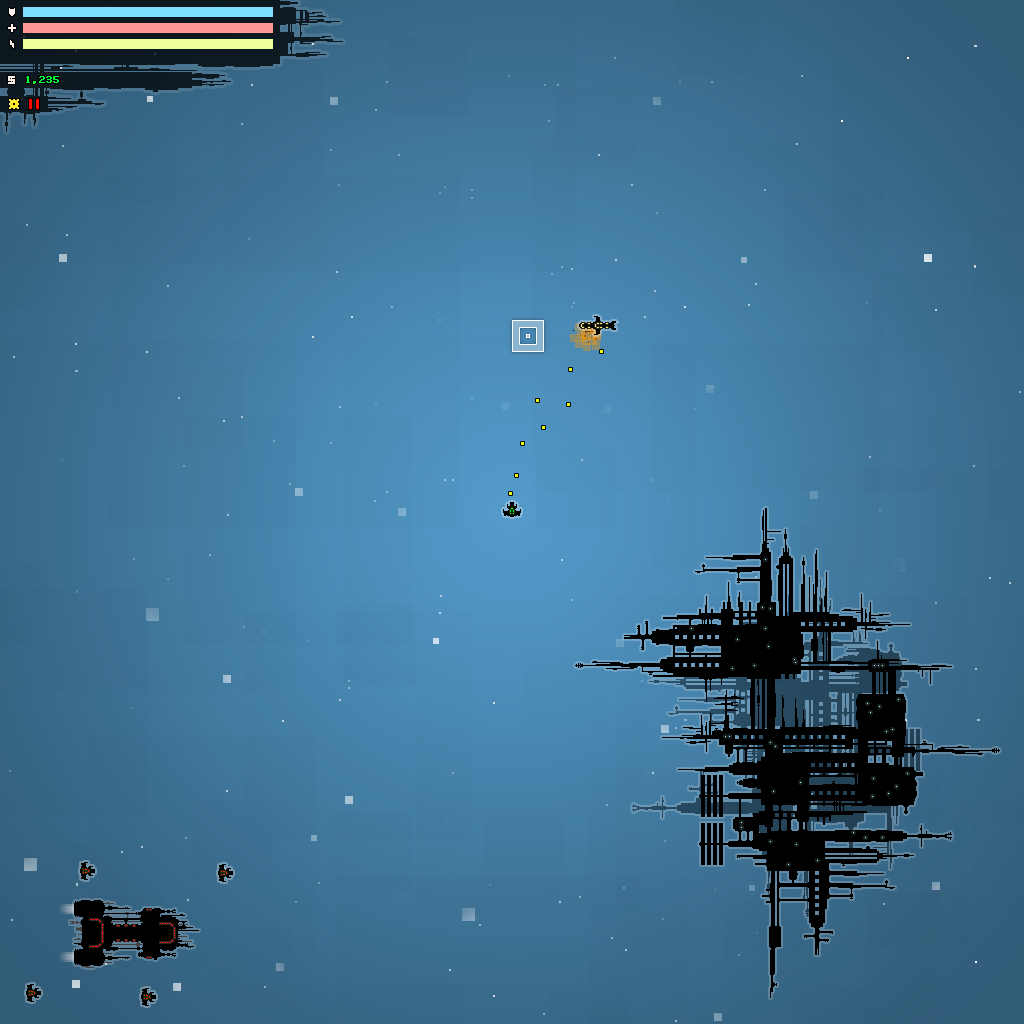
By the end of that day I had a controllable space ship that could shoot at rocks to destroy them. How Masteroid grew from there is catalogued in the release notes and blog posts on this site as well as in the game itself. But here’s what the game looks like right now, in the last release for 2017:

What started as a one-day, solo game jam turned into a pretty major indie game effort that has been more enjoyable, continually motivating and genuinely fun, than any other game effort I’ve worked on. My goal with Masteroid was to get a playable game to market as soon as humanly possible and release frequent updates.
So, without further ado let’s get completely transparent with every metric I can provide for Masteroid in 2017!
Release History
Masteroid featured 9 total releases, each adding significant features and content over the previous. Gamers that purchased Masteroid at any point this year got free access to every update with no loot crates, IAP or other transactions! These were the release highlights for 2017.
- Masteroid started from scratch on April 24
- Masteroid v0.1.0 (Jun 29th): “Foundation” update, allows you to fly a space ship around, shoot asteroids and upgrade weapons.
- Masteroid v0.1.1 (Jul 9th): Patch released to beta signups – first version played by people I don’t know personally!
- Masteroid v0.1.2 (Jul 15th): Patch fixed some bugs, improved AI and added WASD controls.
- Masteroid v0.1.3 (Jul 29th): Patch enabled Mac release, plus first version of sector editing tools, added content and fixed tons of bugs.
- Masteroid v0.2 (Aug 26th): “Faction Missions” update added factions and faction reputation (plus UI for most of these things).
- Masteroid v0.3 (Sep 28th): “Fleets” update improved weapon equipping, added fleets and made combat way more exciting.
- Masteroid v0.4 (Oct 23rd): “Stations” update added unique, tiled-based stations, improved UI and started focusing on improving tools.
- Masteroid v0.5 (Nov 29th): “Sectors” update overhauled all sectors and sector art using brand new tools. New ships brought total to 15 playable ships.
- Masteroid v0.6 (Dec 27th): “Weapons” update overhauled all weapons and art. New weapons brought total to 20 equippable weapons
Analytics
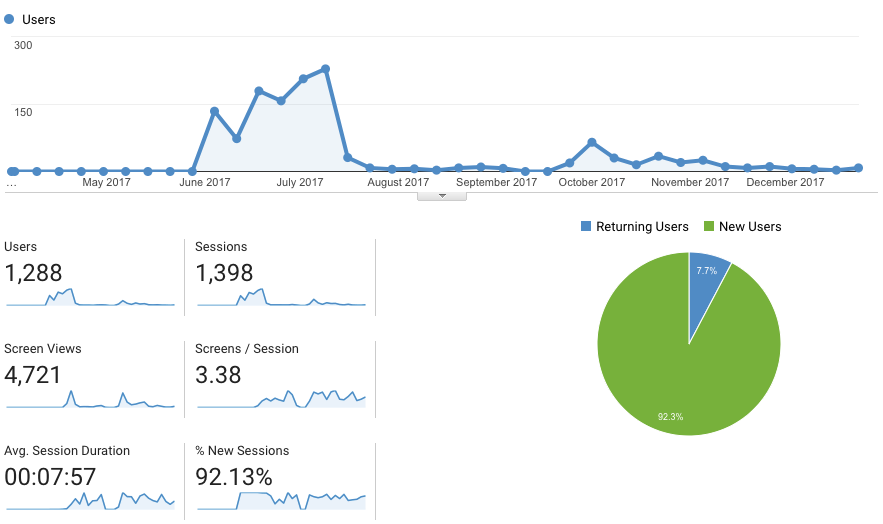
Masteroid has been played a total of 186 hours since launch. Some of the early numbers were inflated by my own testing play time. I fixed this in July so that my debug testing didn’t count as gameplay. The total playtime is fairly accurate as my development sessions are very short. However, the unique number of gameplays is probably inflated by June and July development sessions (as you can see in the chart above). Additionally, I gave away a lot of free keys to closed beta signups so the game got a rush of free plays that died out pretty quickly.
There is a direct correlation between how much effort I spend posting gifs, screenshots, etc online and how many people purchase, download and/or play the game. I spend the vast majority of my time doing actual production work and don’t take enough time to market the game. The rapid release cycle often gives me this mentality of “the next version will be better, I’ll market it then”. But the next version will always be better (hopefully) so at some point I will have to carve more marketing and promotion time from my dev schedule if I want anyone to play it.
Finally, Masteroid is surprisingly popular in Russia despite zero effort to translate it or market it there. From September onward, the US only accounted for only 24% of game sessions. Russia accounted for 47% and the Ukraine drove another 18% of sessions. Given that there are more Russian users than I gave away game keys, and I don’t have any obviously-Russian purchasers, I suspect that most of this traffic is from “shared” copies of the game (aka pirated). Supporting this is the fact that every single one of these sessions was from the same version of the game. Users with a valid key would be likely to upgrade to the latest since there’s no cost to do so and each update adds quite a bit of content!
Since I’m not marketing, translating or supporting Russian users I don’t really consider this “lost sales.” I have the ability to deliver news and updates, even to older copies of the game so their gameplay sessions are an advertising opportunity for me. The average session duration for Russian gameplays is significantly longer than the US average. So I have a fairly-engaged audience that could translate into a paying customer if I focus on that.
Financials
I have the luxury and privilege of not relying on Masteroid for financial gain. I would like to make money, at least enough to break even on my time investment, but my family doesn’t starve if Masteroid doesn’t sell copies. From the beginning my goal was minimize the cash investment in the game, maximize the playable content for each hour of development I spend and HAVE FUN building something that I’m proud of. This means Masteroid may never be as deep or sexy as a game with higher cash investment… but I also avoid burnout for longer and don’t endanger my personal finances.
This is the cash I have spent to make Masteroid. Note that I’m not counting costs for SaaS like Creative Cloud and my web server because I already pay for those for other reasons. Also note that spending that small of an amount of money on Facebook Ads is an utter waste of time:
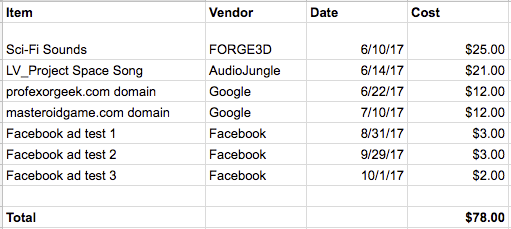
And this is what Masteroid has earned:

So in pure cost terms, Masteroid is about $23 in the hole. If I consider it a hobby, it’s a pretty cheap hobby. However, it’s not even generating even enough income to buy more sound and other assets. Now let’s take a look at my time commitment:
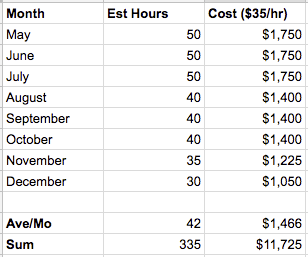
Payscale.com claims the average software developer wage is $69k/yr. Given my experience level and bill rate in my “real” career, $35/hr is a fantastic deal on my time (in the US at least). Masteroid would have had to make almost $12k to generate reasonable income for my time.
Conclusion
I’ve had a good time working on this project but it would have to find a [paying] audience quickly to break even on my time. So if you are a hobbiest you can have a lot of fun making a game that people actually play without costing you much. But if you want to make a serious run at a career in indie games you better:
- Spend way more time and money on marketing
- Control your costs
- Be able to do most of the work yourself
- Have the cash to eat for months
- Find an audience that is willing to pay for the game (harder than just finding players)
- Understand how to implement, review and react to analytics at least as well as I do!
Masteroid has taught me some really important skills. Forcing myself to adhere to a monthly release schedule, be realistic about what I can and can’t build; and work within strict time, cost and style constraints has taught me an enormous amount about scope and project management. I can’t highlight enough how valuable it is to either work on a roadmap and release schedule that gets continual updates in front of gamers, or join game jam teams to learn how to create realistic scopes for durations.
Thanks for taking the time to read my gamedev experience. I intend to continue working on Masteroid. If you think the game looks interesting, has promise or just found this transparent information useful please consider purchasing the game!
Sincerely,
